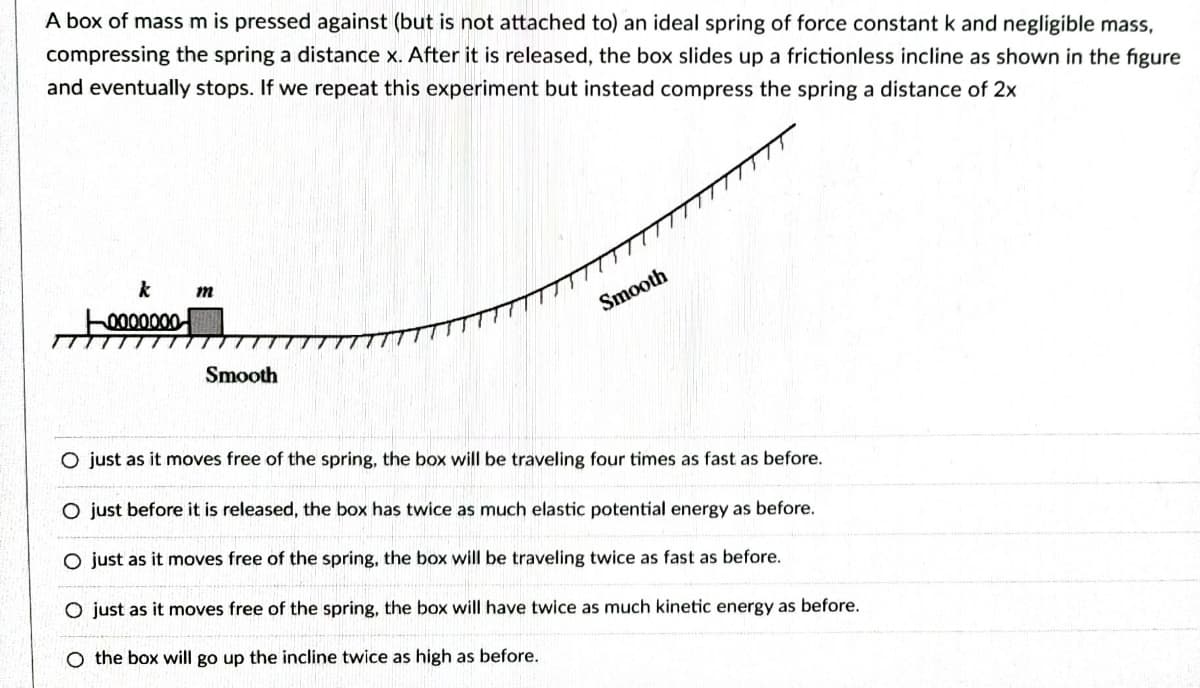A box of mass m is pressed against (but is not attached to) an ideal spring of force constant k and negligible mass, compressing the spring a distance x. After it is released, the box slides up a frictionless incline as shown in the figure and eventually stops. If we repeat this experiment but instead compress the spring a distance of 2x k 0000000 Smooth Smooth O just as it moves free of the spring, the box will be traveling four times as fast as before. O just before it is released, the box has twice as much elastic potential energy as before. O just as it moves free of the spring, the box will be traveling twice as fast as before. O just as it moves free of the spring, the box will have twice as much kinetic energy as before. O the box will go up the incline twice as high as before.
A box of mass m is pressed against (but is not attached to) an ideal spring of force constant k and negligible mass, compressing the spring a distance x. After it is released, the box slides up a frictionless incline as shown in the figure and eventually stops. If we repeat this experiment but instead compress the spring a distance of 2x k 0000000 Smooth Smooth O just as it moves free of the spring, the box will be traveling four times as fast as before. O just before it is released, the box has twice as much elastic potential energy as before. O just as it moves free of the spring, the box will be traveling twice as fast as before. O just as it moves free of the spring, the box will have twice as much kinetic energy as before. O the box will go up the incline twice as high as before.
College Physics
11th Edition
ISBN:9781305952300
Author:Raymond A. Serway, Chris Vuille
Publisher:Raymond A. Serway, Chris Vuille
Chapter5: Energy
Section: Chapter Questions
Problem 64AP: A ball of mass m = 1.80 kg is released from rest at a height h = 65.0 cm above a light vertical...
Related questions
Question
15

Transcribed Image Text:A box of mass m is pressed against (but is not attached to) an ideal spring of force constant k and negligible mass,
compressing the spring a distance x. After it is released, the box slides up a frictionless incline as shown in the figure
and eventually stops. If we repeat this experiment but instead compress the spring a distance of 2x
0000000
Smooth
Smooth
O just as it moves free of the spring, the box will be traveling four times as fast as before.
O just before it is released, the box has twice as much elastic potential energy as before.
O just as it moves free of the spring, the box will be traveling twice as fast as before.
O just as it moves free of the spring, the box will have twice as much kinetic energy as before.
O the box will go up the incline twice as high as before.
Expert Solution
This question has been solved!
Explore an expertly crafted, step-by-step solution for a thorough understanding of key concepts.
This is a popular solution!
Trending now
This is a popular solution!
Step by step
Solved in 4 steps

Knowledge Booster
Learn more about
Need a deep-dive on the concept behind this application? Look no further. Learn more about this topic, physics and related others by exploring similar questions and additional content below.Recommended textbooks for you

College Physics
Physics
ISBN:
9781305952300
Author:
Raymond A. Serway, Chris Vuille
Publisher:
Cengage Learning

Principles of Physics: A Calculus-Based Text
Physics
ISBN:
9781133104261
Author:
Raymond A. Serway, John W. Jewett
Publisher:
Cengage Learning

University Physics Volume 1
Physics
ISBN:
9781938168277
Author:
William Moebs, Samuel J. Ling, Jeff Sanny
Publisher:
OpenStax - Rice University

College Physics
Physics
ISBN:
9781305952300
Author:
Raymond A. Serway, Chris Vuille
Publisher:
Cengage Learning

Principles of Physics: A Calculus-Based Text
Physics
ISBN:
9781133104261
Author:
Raymond A. Serway, John W. Jewett
Publisher:
Cengage Learning

University Physics Volume 1
Physics
ISBN:
9781938168277
Author:
William Moebs, Samuel J. Ling, Jeff Sanny
Publisher:
OpenStax - Rice University

Classical Dynamics of Particles and Systems
Physics
ISBN:
9780534408961
Author:
Stephen T. Thornton, Jerry B. Marion
Publisher:
Cengage Learning

An Introduction to Physical Science
Physics
ISBN:
9781305079137
Author:
James Shipman, Jerry D. Wilson, Charles A. Higgins, Omar Torres
Publisher:
Cengage Learning